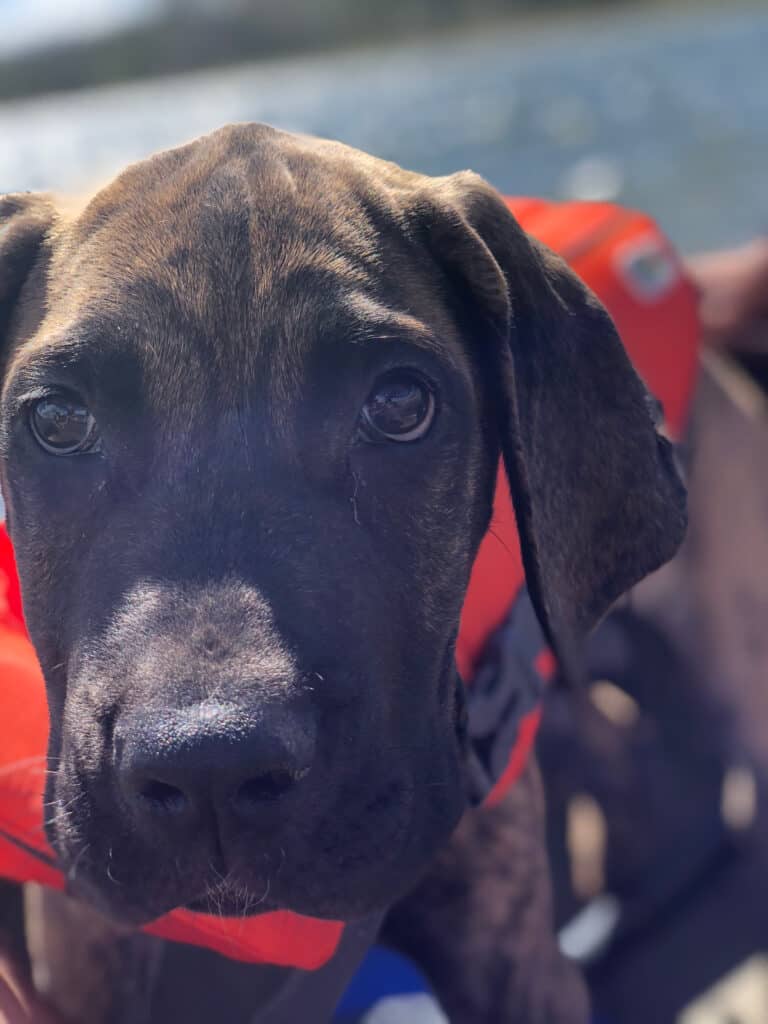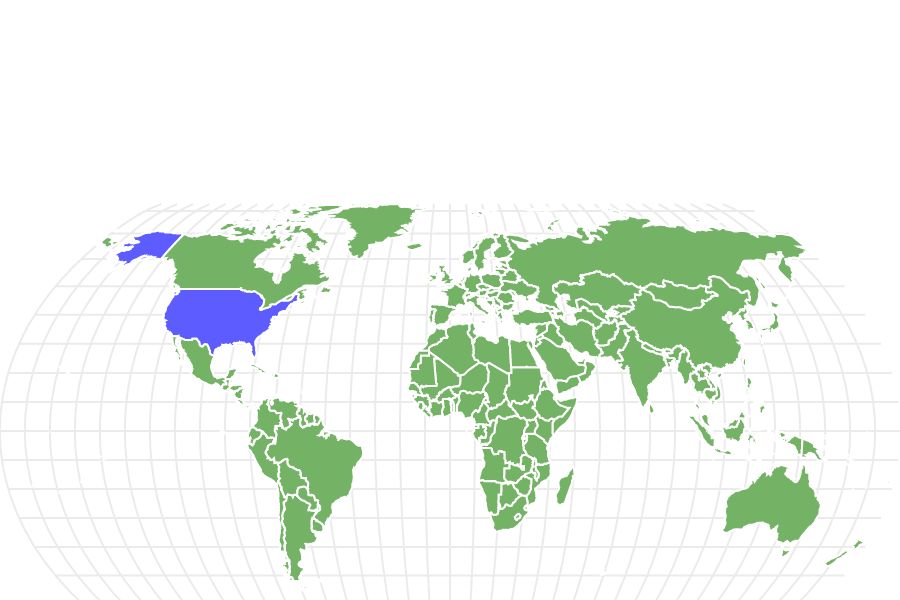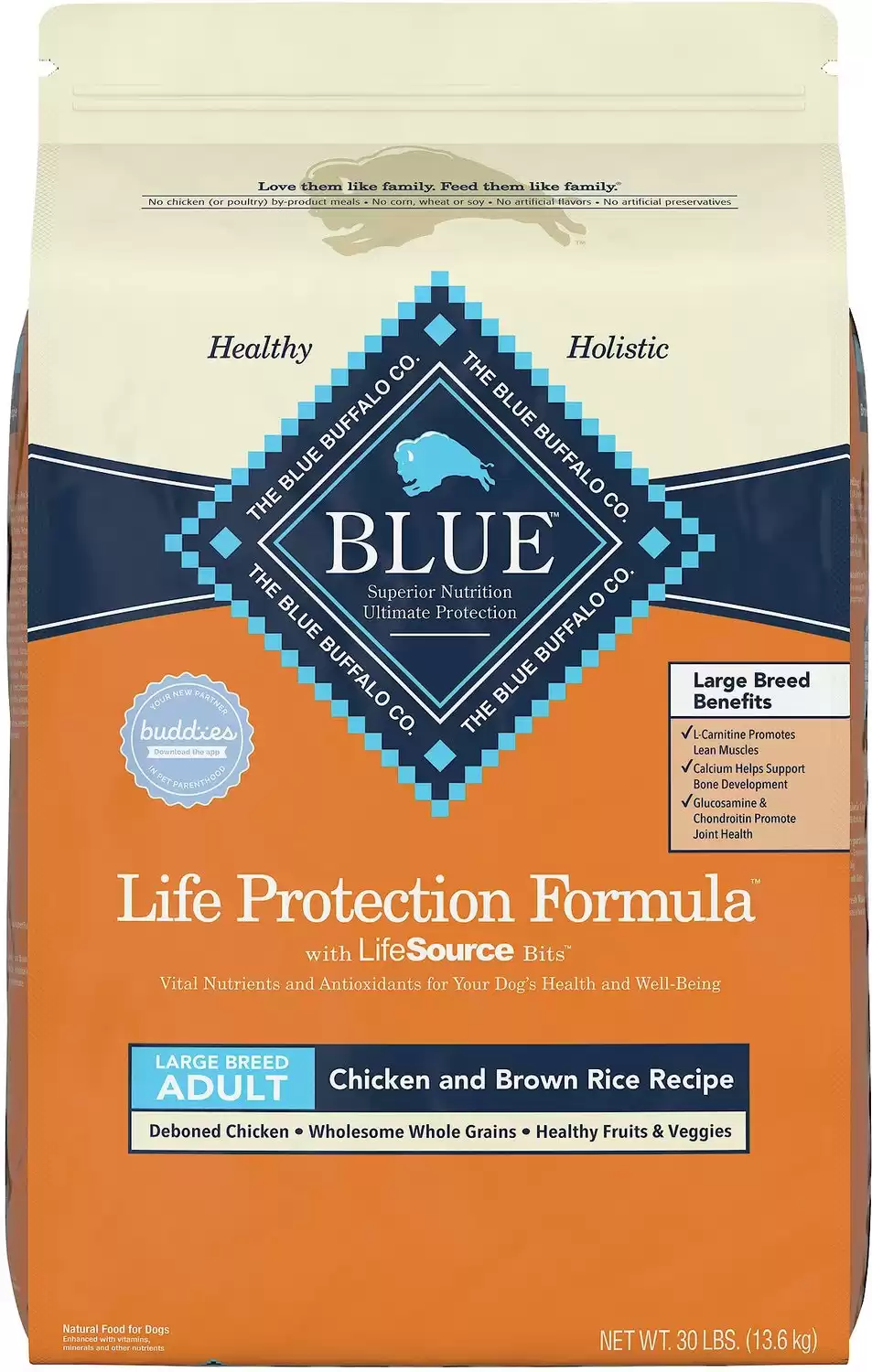Daniff
Canis lupus familiaris
Advertisement
Daniff as a Pet:
- General Health
- Energy Level
- Shedability
- Trainability
- Intelligence
- Tendency to Chew
- Size
- Family and kid friendliness
- Yappiness / Barking
- Low
- Separation Anxiety
- High
- Preferred Temperature
- Average climate
- Exercise Needs
- Moderate
- Friendly With Other Dogs
- High
- Pure bred cost to own
- Initial purchase: $500-$900; food, healthcare and maintenance: $1,440 a year.
- Dog group
- Sporting
- Male weight
- 115-190 lbs
- Female weight
- 115-190 lbs
This post may contain affiliate links to our partners like Chewy, Amazon, and others. Purchasing through these helps us further the A-Z Animals mission to educate about the world's species.
View all of the Daniff images!
“The ancestors of this breed were used as war dogs by the Mongolian leader Kublai Khan.”
Daniff Introduction
The Daniff is a recent American mixture of two large breed dogs, the great Dane and the mastiff, breeds with ancient origins in Tibet and the Middle East. The original breeds were developed for hunting large game but over the years have become more popular as companion animals. Despite their imposing size, Daniffs are not aggressive and make gentle, playful, and loyal family pets. They get along very well with children and other animals. At the same time, they are protective and make great watchdogs, intimidating potential intruders as much by their size as their bark. On the downside, they are expensive to maintain, but many families will find the investment well worth it.
3 Pros and Cons of Owning a Daniff
| Pros! | Cons! |
|---|---|
| Good protectors. Although they are gentle giants, strangers will find their size and deep barks intimidating. This combination is ideal for someone looking for a trustworthy guard dog. | Expensive. Giant breed dogs are expensive to maintain. They eat an enormous amount of food and have high vet bills because of the health conditions endemic to large breeds. |
| Great with kids and pets. Daniffs are affectionate toward children and other animals. They do have herding instincts and a love of rambunctious play, though, and can bowl over small children and animals with their size. | Chaotic and messy. Daniffs will climb up into your lap no matter how big they get and knock things off your coffee table with their whip-like wagging tails. They drool a lot and they leave king-sized feces in your yard. This just means they need an owner with a lot of love and patience. |
| Low-maintenance coats. Daniffs are a smooth-haired breed that should be brushed weekly, and more often when shedding. Some of them inherit wrinkly skin from their mastiff side. These should be wiped with a damp washcloth and dried thoroughly to prevent infection. | Separation anxiety. Daniffs don’t like to be left alone. If left for an extended time they will act out by barking and destroying things. |
The Best Dog Food for Daniffs
Dog owners of any breed are recommended to provide their pet with a high-quality dog food made with natural ingredients and as few artificial additives and low-nutritional fillers as possible. Spending more on better quality food is an important part of preventative healthcare that can save you expensive vet bills in the future.
It is also best to provide foods specially formulated for the developmental stage of your dog: puppy, adult, or senior. Follow the recommended portions closely and do not feed your dog table scraps, as they can have a tendency toward obesity if overfed or given calorie-rich people food.
At A-Z Animals we recommend Blue Buffalo Life Protection Formula. Real meat is the first ingredient, supplemented with whole grains, vegetables, and fruit. It’s designed by animal nutritionists and holistic veterinarians to include an exact blend of antioxidants, vitamins, and minerals to help your dog maintain a healthy immune system. It comes in formulations for dogs of different ages and in several different flavors, such as chicken and brown rice or lamb and oatmeal. It has the benefits of a more expensive brand while still being affordable, which is an important consideration when feeding a constantly hungry large breed.
- Chicken and brown rice recipe designed for large breeds
- Glucosamine for joint health
- Omega 3 and 6 fatty acids for healthy skin and coat
- Calcium and phosphorus for strong bones and teeth
Size and Weight
Daniffs are considered a giant-breed dog with an average height of 27-33 inches and weight of 115-190 pounds. Their large size can predispose them to problems with their bones and joints.
| Height (Male) | 27-33″ Tall |
| Height (Female) | 27-33″ Tall |
| Weight (male) | 115-190 lbs, fully grown |
| Weight (female) | 115-190 lbs, fully grown |
Common Health Issues
Daniffs can inherit the health issues that are most common to their parent breeds: great Danes and mastiffs. Hybrid breeds do tend to be hardy, but it is unpredictable how healthy an individual puppy will turn out to be.
Some of the issues most frequently reported are bloat, hip and elbow dysplasia, heart issues, cancer, eye problems, skeletal issues, and hypertrophic osteodystrophy. It’s important to keep your dog on a good diet throughout its developmental stages and have regular veterinary checkups to catch any issues early on.
In summary, these are the issues you may be most likely to encounter with Daniffs:
- Bloat
- Hip and elbow dysplasia
- Heart issues
- Cancer
- Eye problems
- Skeletal issues
- Hypertrophic osteodystrophy
Temperament and Behavior
To people unfamiliar with the breed, a Daniff can be highly intimidating with its large size and deep voice. It is protective of its family but will only show aggression when it feels threatened. If you’re friendly, you might actually find it more likely you’ll get knocked down and kissed all over the face than bitten.
Puppies will bond strongly with their humans, including children, who they adore. They also adjust well to other pets, including dogs and cats. Some training is required to help them learn good manners and not overwhelm others with the size and enthusiasm of their love. Daniffs can have a stubborn streak, but they are also quite eager to please. Love, positive reinforcement, and consistency are the keys to effective training.
How to Take Care of a Daniff
Maintenance and Grooming

The Daniff comes in many colors and has a very low-shedding coat.
©Spockfoundwaldo/Shutterstock.com
Daniffs have short soft fur that is relatively low maintenance. They come in six colors: fawn with a black mask, brindle, blue, black, harlequin (white with irregular patches all over), and mantle (black and white with solid black on their backs, like a blanket.)
This breed has a very low-shedding coat, but the size of the animal means that even this low level of shed will leave a lot of hair and dander around your house. In normal times, they should be brushed once a week, but during the shedding season, two or more times may be required to control the hair.
Some puppies inherit wrinkled skin from their mastiff ancestors. The wrinkles should be periodically cleaned by wiping with a damp washcloth, making sure to dry the area thoroughly to prevent bacterial growth between the folds.
Nail clipping can be a real challenge in an adult dog that decides it doesn’t like it. Because they can be difficult to control physically once they get large, it’s important early in puppyhood to get them accustomed to having their paws held and their nails clipped. This can be an early, regular practice even if it is just “pretend” to help them be more comfortable with the experience.
Training
Daniffs are very intelligent, loving, and eager to please. Most of the time they are quite submissive. However, at times they can be stubborn. It’s important to start obedience training with them as early as possible, as a poorly trained adult can be quite unmanageable as a pet. If you feel ill-equipped to train your puppy yourself, invest in professional training. One way or another, training is an absolute must with this breed.
One advantage of a training program with other dogs is that it will help them socialize with other pups and humans. Their protective instincts are one of their strengths, but they have to learn the difference between friends and potential threats, remembering that you are in charge and taking their cues from you.
Exercise
Daniff puppies are energetic and require a moderate amount of exercise. Two long walks a day are recommended, along with play time in a fenced yard. They enjoy playing chase, tag, and catch with their humans as well. They’re very social and will act out with behaviors such as chewing and barking if left alone too long.
Despite their size, they are still really indoor dogs at heart and will want to sleep with you in the house at night rather than a kennel. At the same time, these are not great pets for cramped apartment living. The ideal environment for them is a large home with a fenced backyard where a family member will be home most of the time.
Daniffs and Children
Daniffs are loving and affectionate toward children and other animals, such as dogs, cats, rabbits, etc. They have a low prey instinct and will tolerate smaller beings very well without deliberately hurting them. However, they do have herding instincts and can become over-excited and rambunctious. They can also be quite clumsy. It’s easy for them to forget their size and bowl over smaller children and animals. Parents should provide supervision until their children are old enough not to be hurt by the Daniff’s enthusiastic nature.
Dogs Similar to the Daniff
- English mastiff – This dog is similar in size to the Daniff but has a much shorter life expectancy of only six to 10 years. Mastiffs drool and shed more than Daniffs.
- Great Dane – Great Danes are similar in size to Daniffs. Danes shed more but are easier to groom and have somewhat better health. Nevertheless, Danes do have a shorter life expectancy of only seven to 10 years.
- American Pit Bull Terrier – Pit bulls are much smaller than Daniffs and live longer, up to 16 years. They are slightly less friendly with children and strangers but have similar intelligence and trainability as the Daniff.
Most Popular Names
Popular names for male Daniffs include:
- Moose
- Diesel
- Apollo
- Scooby
- Gunnar
Popular names for female Daniffs include:
- Lily
- Luna
- Stella
- Daisy
- Sadie
Related Animals
View all 110 animals that start with DDaniff FAQs (Frequently Asked Questions)
How much does a daniff cost to own?
Initial purchase price of a daniff puppy is $600-$900. Annual maintenance, veterinary care, and food is approximately $1,440 a year. They eat a lot and have some health issues that will require regular veterinary attention.
Is the daniff good with kids?
Yes, they are protective, affectionate, playful, and gentle with kids and other pets. However, they are very large animals and are clumsy, have herding instincts, and can get over-excited and knock kids down without meaning to hurt them. So parents should closely supervise interactions between this dog and small children.
How long does a daniff live?
The average life expectancy of a daniff is eight to 12 years.
Thank you for reading! Have some feedback for us? Contact the AZ Animals editorial team.
Sources
- Dogtime.com, Available here: https://dogtime.com/dog-breeds/daniff#/slide/1
- Perfect Dog Breeds, Available here: https://www.perfectdogbreeds.com/great-dane-mastiff-mix/
- Wag!, Available here: https://wagwalking.com/breed/daniff
- Hepper.com, Available here: https://www.hepper.com/daniff/
- DogLearn.com, Available here: https://www.dog-learn.com/dog-breeds/daniff/
- Petsmont.com, Available here: https://www.petsmont.com/blogs/pets/top-facts-regarding-the-daniff-dog
- Petguide.com, Available here: https://www.petguide.com/breeds/dog/daniff/
- K9ofmine, Available here: https://www.k9ofmine.com/daniff-great-dane-english-mastiff-mix/


















